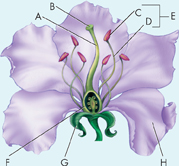24 Assessment
24.1 Reproduction in Flowering Plants
Understand Key Concepts
In angiosperms, the structures that produce the male gametophyte are called the
anthers.
sepals.
pollen tubes.
stigmas.
Pollination occurs when pollen lands on
the style.
the stigma.
the filament.
the anther.
The process in which a single plant produces many offspring genetically identical to itself is
sexual reproduction.
agriculture.
dormancy.
vegetative reproduction.
What is a carpel? Where is it located in a typical flower?
Describe at least two ways in which pollen is transferred from one plant to another.
What are the products of double fertilization? Describe them.
Think Critically
Interpret Visuals The diagram below shows the parts of a typical flower.

Inside which structure is pollen produced?
What structure is represented by A? What is its function?
In which structure do seeds develop?
What is the name of structure G?
24.2 Fruits and Seeds
Understand Key Concepts
The thickened ovary wall of a plant may join with other parts of the flower to become the
fruit.
seed.
endosperm.
cotyledon.
The period during which the embryo is alive but not growing is called
fertilization.
vegetative growth.
dormancy.
germination.
Give examples of seed dispersal by animal, wind, and water.
What is the function of dormancy?
Think Critically
Predict Some plants form flowers that produce stamens but no carpels. Could fruit form on one of these flowers? Explain your answer.
Infer The seeds of lupines, an arctic plant, can remain dormant for thousands of years. Why might this trait be important to a plant in an arctic environment?
Design an Experiment A friend suggests that seeds do not need cotyledons to grow. You argue that cotyledons are important to seeds. Design a controlled experiment that shows the effect on seed growth of removing cotyledons.
24.3 Plant Hormones
Understand Key Concepts
Chemical signals in plants affecting the growth, activity, and development of cells and tissues are called
hormones.
enzymes.
auxins.
phytochromes.
Substances that stimulate cell division and cause dormant seeds to sprout are
gibberellins.
auxins.
cytokinins.
phytochromes.
Table of Contents
- Formulas and Equations
- Applying Formulas and Equations
- Mean, Median, and Mode
- Estimation
- Using Measurements in Calculations
- Effects of Measurement Errors
- Accuracy
- Precision
- Comparing Accuracy and Precision
- Significant Figures
- Calculating With Significant Figures
- Scientific Notation
- Calculating With Scientific Notation
- Dimensional Analysis
- Applying Dimensional Analysis




